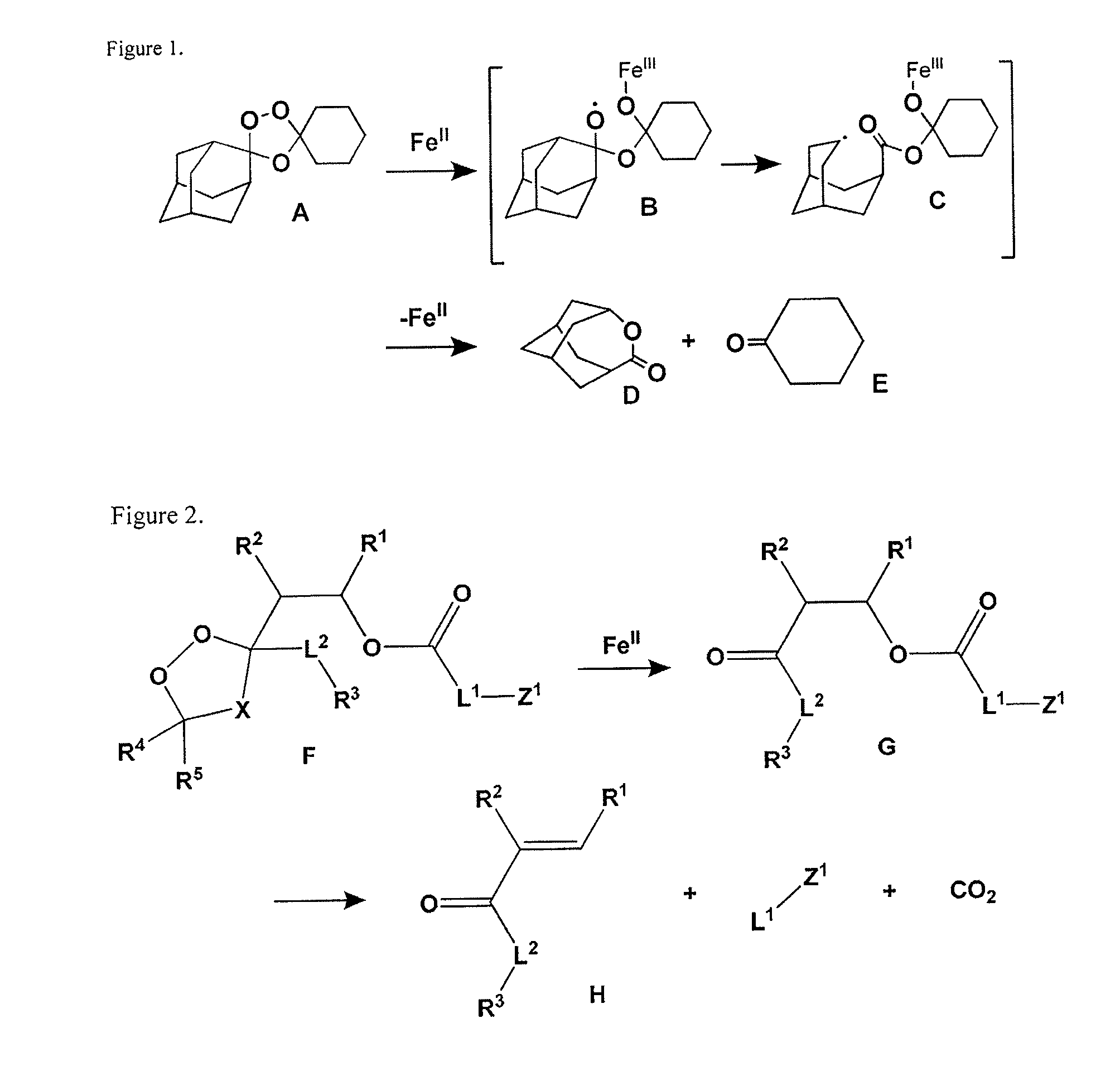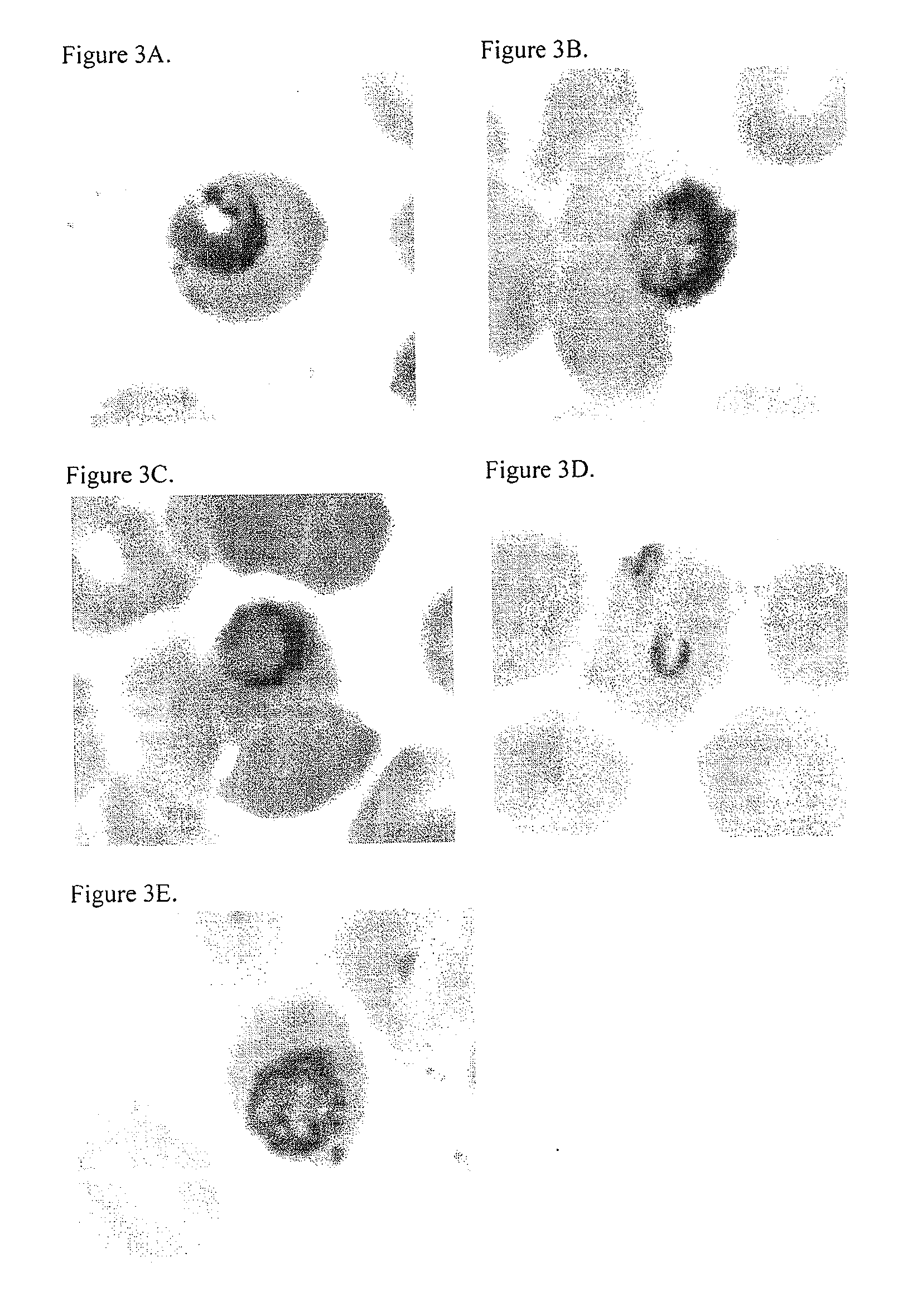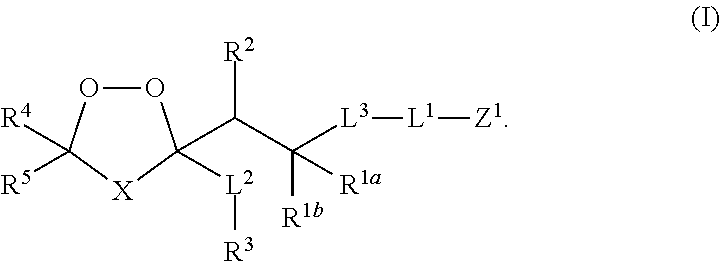Prodrug and Fluoregenic Compositions and Methods for Using the Same
a fluoregenic composition and composition technology, applied in the field of chemotherapeutic agents, can solve the problems of reducing efficacy, causing patients to suffer, and many of the therapeutics used to treat infectious diseases, including parasitic diseases, to confer undesirable side effects
- Summary
- Abstract
- Description
- Claims
- Application Information
AI Technical Summary
Benefits of technology
Problems solved by technology
Method used
Image
Examples
example 1
Preparation of 2-(5,5-spiroadamantyl-3-(3-(2-morpholinoethylamino)-3-oxopropyl)-1,2,4-trioxolan-3-yl)ethyl-2,5-dichlorophenylcarbamate
[0162]
Step 1: Preparation of O-methyl 2-adamantanone oxime
[0163]
[0164]2-Adamantanone (1.3 g, 10 mmol) and methoxylamine hydrochloride (1.3 g, 15.56 mmol) were dissolved in methanol (30 ml). To this solution was added pyridine (1.5 ml, 18.5 mmol) and the reaction was stirred for 2 days. The solvent was evaporated to afford a viscous liquid which was then dissolved in dichloromethane. The organic layer was washed successively with 1N HCl (30 ml), brine (30 ml) dried with MgSO4, filtered, and evaporated to afford a white colored crystalline solid. Yield: 1.5 g (83%). MS (m / z): (M+H)=180.
Step 2: Preparation of adamantane-2-spiro-3′-8′-oxo-1′,2′,4′-trioxaspiro[4.5]decane
[0165]
[0166]O-methyl 2-adamantanone oxime (4.5 g, 25 mmol) and 1,4 cyclohexanedione (5.6 g, 50 mmol) were dissolved in a solvent mixture of pentane:dichloromethane (1:1.5). The flask was co...
example 2
Preparation of 2-(5,5-spiroadamantyl-3-(3-(2-morpholinoethylamino)-3-oxopropyl)-1,2,4-trioxolan-3-yl)ethyl 4-phenylpiperazine-1-carboxylate
[0172]
Step 1. Preparation of 2-(5,5-spiroadamantyl-3-(3-(2-morpholinoethylamino)-3-oxopropyl)-1,2,4-trioxolan-3-yl)ethyl 4-nitrophenyl carbonate
[0173]A solution of 3-(3-(2-hydroxyethyl)-5,5-spiroadamantyl-1,2,4-trioxolan-3-yl)-N-(2-morpholinoethyl)propanamide (310 mg, 0.729 mmol) in anhydrous dichloromethane (25 ml) was treated with triethylamine (202 μl, 1.45 mmol), p-nitrophenyl chloroformate (294 mg, 1.45 mmol) and dimethylaminopyridine (89 mg, 0.729 mmol). The reaction mixture was stirred under argon for 4 hrs after which time the reaction mixture was washed thrice with 20 mL saturated aqueous NaHCO3, dried (Na2SO4), filtered, and evaporated to afford an oil. The oil was further purified using silica gel chromatography (0-5% MeOH—CH2Cl2) to afford a yellow solid. Yield: 300 mg (70%). MS (m / z): (M+H)=590.
Step 2. Preparation of 2-(5,5-spiroadam...
example 3
Preparation of 2-(5,5-adamantyl-3-(3-(2-morpholinoethylamino)-3-oxopropyl)-1,2,4-trioxolan-3-yl)ethyl phenyl carbonate
[0175]
[0176]A solution of 2-(5,5-spiroadamantyl-3-(3-(2-morpholinoethylamino)-3-oxopropyl)-1,2,4-trioxolan-3-yl)ethyl 4-nitrophenyl carbonate (16 mg, 0.027 mmol) in anhydrous dichloromethane (1 ml) was treated with phenol (2.6 mg, 0.027 mmol) and 4-dimethyl aminopyridine (2 mg, 0.027 mmol) and the reaction was stirred at 50° C. under argon for 4 hrs. The reaction mixture was diluted with more dichloromethane and washed with saturated aqueous NaHCO3, dried (Na2SO4), filtered, and evaporated. The residue was purified using silica-gel chromatography (0-5% MeOH—CH2Cl2) to afford the title compound. Yield: 10 mg (68%). MS (m / z): (M+H)=545.
PUM
| Property | Measurement | Unit |
|---|---|---|
| temperatures | aaaaa | aaaaa |
| temperatures | aaaaa | aaaaa |
| temperatures | aaaaa | aaaaa |
Abstract
Description
Claims
Application Information
 Login to View More
Login to View More - R&D
- Intellectual Property
- Life Sciences
- Materials
- Tech Scout
- Unparalleled Data Quality
- Higher Quality Content
- 60% Fewer Hallucinations
Browse by: Latest US Patents, China's latest patents, Technical Efficacy Thesaurus, Application Domain, Technology Topic, Popular Technical Reports.
© 2025 PatSnap. All rights reserved.Legal|Privacy policy|Modern Slavery Act Transparency Statement|Sitemap|About US| Contact US: help@patsnap.com



